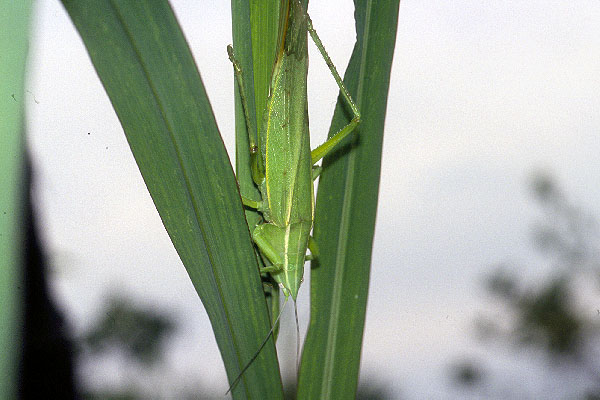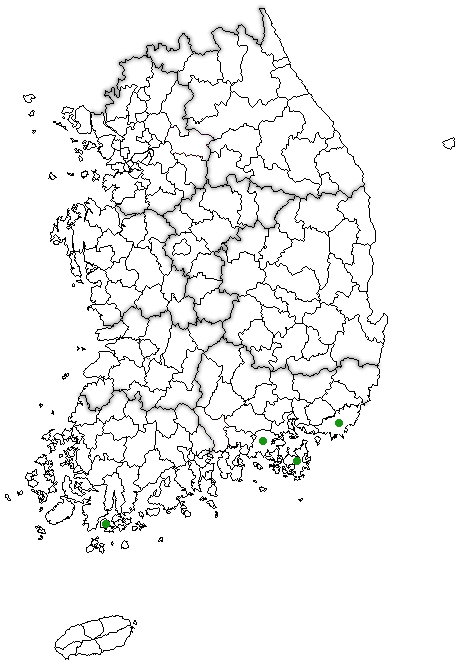여치베짱이
[=큰여치]
Pseudorhynchus japonicus Shiraki 1930
몸길이는 약 60-67 ㎜로 크고 뚱뚱하다. 녹색형과 갈색형이 있다. 얼굴이 크고 볼록하며 노란 빛을 띤다. 두정돌기는 뾰족하고 기부에 작은 혹이 있으며 더듬이는 몸길이보다 길지 않고 윗면은 연녹색, 아랫면은 검은 색이다. 앞가슴등판의 양 가장자리에 황백색 선이 있다. 커다란 매부리처럼 보인다. 일본에도 분포한다.

암컷
(Female)
Original description:
Pseudorhynchus
japonicus Shiraki 1930
Trans. Nat. Hist. Soc. Formosa 20: 341.
♂. Small. Fastigium of vertex hardly
reaching the tip of second antennal joint, sharply pointed, with
3 somewhat distinct carinae, of which the 1ower one is elevated
spine-like at the 1ower end. Fastigium of frons very low, but distinctly
separated from that of vertex. Face strongly oblique, more or less
convex. Eyes very small, shorter than the first antennal joint,
when seen from side somewhat round but the front margin nearly straight.
Apical joint of maxillary palpi as long as the second and third
joints together, slender with the tip strongly swollen.
Pronotum
rather short, gradually broadened behind, nearly horizontal, with
the front margin straight and hind margin slightly convex; lateral
carinae straight, somewhat distinct; main sulcus far front the middle,
nearly straight, the second sulcus in the middle very short and
V-shaped, the last sulcus very inconspicuous and slightly curved
hehind, a short longitudinal sulcus between the first and second
sulcus rather distinct. Lateral lobes much broader than long, with
the front margin straight and hind margin S-like curved, the lower
margin being horizontal with the front angle obtusely rounded. Prosternal
spines simple. Mesosternal lobes rather broad, truncate; metasternnal
lobes broader than long; nearly triangular.
Abdomen
reaching the end of abdomen. Last abdominal tetgite transverse,
with two wide distant longitudinal carinae which are ending at the
tip of somewhat triangular latera1 lobes, the later being not sharply
pointed. Subgenital plate short, with two triangular apical lobes
which are provided rather long styli. Cerci of ma1e very broad,
the interior furrow very broad and deep, when seen from outer side
about 1.5 times as long as wide; apical spine well-developed and
right-angularily curved inwards but slightly below; basal process
very long, right angularily directing towards the dorsum, with the
inner surface deeply furrowed longitudinally.
Elytra
elongate, narrow, with the apical margin narrowly rounded; tympanal
mirror subquadrate, a little longer than basal broad, with the hind
margin very slightly convex. Wings not reaching the apex of elytra.
Legs
short; coxal spine long, hardly reaching the tip of the trochanter,
moderately curved; spines of legs moderate in size.
General
coloration pale green; lateral carinae of pronotum and thick portion
of cubital vein yellowish, the color extending the inner margin
of eyes; under side of antennae black, excepting the two basal joints
unicolor.
Body length, 40-48, pronotum 12-13, elytra
48-50, hind femora 21-22 ㎜; width of hind margin of pronotum 7.5-8
㎜.
Two males from Nakano, Tokyo.
By
much shorter pronotum the new species is conspicuously distinguished
from antennalis
Stal. I have seen Japanese specimen, which has been identified by
Rettentbacher as antennalis
Stal, in the Hof-Museum, Wien, and found that Japanese species is
quite distinct one as well as that antennalis may be lived only
in Philippines.

<참고문헌>
● Doi H. 1934. On the female of Pseudorhynchus japonicus Shiraki. Mushi 7(2): 124-125.
● Kim TW and
Kim JI 2002. Taxonomic study of tribe Copiphorini in Korea (Orthoptera:
Tettigoniidae: Conocephalinae). Korean J. Entomol. 32(3): 153-160.